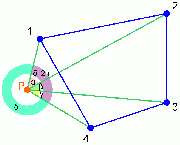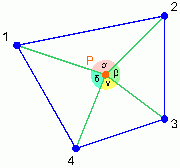Algorithmus - Liegt ein Punkt in einem Polygon?
Kurzbeschreibung
Dieser Algorithmus berechnet, ob ein Punkt in einem Polygon liegt (2D). Der Punkt ist ein X/Y-Koordinatenpaar des Typs stc_Point. Das Polygon ist ein Array, das ebenfalls aus einzelnen Punkten (stc_Point) besteht. In der derzeitigen Implementierung sind nur "gewöhnliche" Polygone möglich; also keine, deren Umfangslinien sich selbst schneiden.
Erstellt wurde dieser Algorithmus u.a. für einen Microcopter, um in bestimmten Bereichen eine Höhenbegrenzung bzw. Mindesthöhe festzulegen. Somit kann man verhindern, dass der Microcopter z.B. über einer Wasserfläche eine Landung zulässt. Ebenso kann man auch bestimmte erhabene Hindernisse festlegen.
-

- Einer der Winkel (hier δ) ist >∏. Da alle Winkel <= ∏ sein müssen, wird von δ 2∏ abgezogen. Winkelsumme damit 0: Punkt liegt ausserhalb
Erklärung
Vom zu prüfenden Punkt aus werden Geraden zu den Eckpunkten des Polygons gezogen. Zwischen diesen Geraden wird die Summe aller Winkel berechnet (vgl. auch Windungszahl).
Ist die Winkelsumme +/-2∏ (+/-360°, Windungszahl +/-1), liegt der Punkt im Polygon. Ist die Winkelsumme 0, liegt der Punkt ausserhalb. Der Sonderfall, dass der Punkt auf einer Kante liegt, wird dadurch erkannt, dass einer der Einzelwinkel +/-∏ (+/-180°) ist. Den Sonderfall, dass der Punkt auf einem anderen Polygon-Eckpunkt liegt, kann man einfach erkennen, in dem man überprüft, ob der Punkt einem der Polygonpunkte entspricht.
Update 2014-05-01
Die bisher verwendete Abfrage im Code, ob die Winkelsumme 0 bzw. +/-2∏ + etwas Toleranz durch die Rundungsfehler beträgt, wurde optimiert. Da die Winkelsumme ja nur 0 oder +/-2∏ annehmen kann, wird einfach der Betrag der Winkelsumme mit ∏ verglichen. Ist der Betrag kleiner, muss die Winkelsumme 0 sein. Ist er grösser, kann die Winkelsumme nur +/-2∏ sein.
Funktionen
PointInPolygon
Parameter:- stc_Point P_loc: Zu prüfender Punkt
- stc_Point *Polygon: Zeiger auf Array mit den Punkten des Polygons
- uint8_t PolygonSize: Anzahl der Punkte des Polygons
- PiP_Corner: Punkt liegt auf einem Eckpunkt des Polygons
- PiP_Edge: Punkt liegt auf einer Kante des Polygons
- PiP_Outside: Punkt liegt ausserhalb des Polygons
- PiP_Inside: Punkt liegt innerhalb des Polygons
- PiP_Unknown: Unerwartetes Ergebnis; sollte nie vorkommen
Code
#include <math.h> #include <stdlib.h> typedef enum{ PiP_Unknown = -3, PiP_Corner = -2, PiP_Edge = -1, PiP_Outside = 0, PiP_Inside = 1 } e_PiP_result; typedef struct{ int32_t x; int32_t y; } stc_Point; e_PiP_result PointInPolygon(stc_Point P_loc, stc_Point *Polygon, uint8_t PolygonSize) { uint8_t pcnt; // Counter for polygon points stc_Point P1; // Point Pn for angle calculation stc_Point P2; // Point P_loc for angle calculation stc_Point P3; // Point Pn+1 for angle calculation stc_Point V_P2P1; // Vector P_loc -> Pn stc_Point V_P2P3; // Vector P_loc -> Pn+1 double angle; // Angle between vectors above double anglesum = 0; // Angle sum P2 = P_loc; // P2 is always the point to check // check, if point is one of the polygon points for (pcnt = 0; pcnt < PolygonSize; pcnt++) { if ((Polygon[pcnt].x == P2.x) && (Polygon[pcnt].y == P2.y)) { // Point to check is polygon point return PiP_Corner; } } for (pcnt = 0; pcnt < PolygonSize; pcnt++) { // P1 = Pn P1 = Polygon[pcnt]; if (pcnt < (PolygonSize-1)) { // P3 = Pn+1 P3 = Polygon[pcnt+1]; } else { // on last Pn, set Pn+1 = P0 and close polygon P3 = Polygon[0]; } // Get vector P2P1 V_P2P1.x = P1.x - P2.x; V_P2P1.y = P1.y - P2.y; // Get vector P2P3 V_P2P3.x = P3.x - P2.x; V_P2P3.y = P3.y - P2.y; // Calculate angle between vectors angle = atan2(V_P2P3.y, V_P2P3.x) - atan2(V_P2P1.y, V_P2P1.x); if ((angle == M_PI) || (angle == -M_PI)) { // if one of the angle is +/-PI, the point is on an edge return PiP_Edge; } // maintain definition range / "limit" angles to range from ]-PI;+PI[ if (angle < (-M_PI)) { angle += (2*M_PI); } else if (angle > (+M_PI)) { angle -= (2*M_PI); } anglesum += angle; } // END: for (pcnt = 0; pcnt < PolygonSize; pcnt++) // The possible values for anglesum are 0 or +/- 2 PI, so we // simply need to check, if the absolute value is less or greater than PI if (abs(anglesum) < M_PI) { return PiP_Outside; } else if (abs(anglesum) > M_PI) { return PiP_Inside; } // we should never land here; but when, we have a separate value for this case return PiP_Unknown; }
Beispiel
Hier ein kleines Beispiel zur Verwendung. Für ein Polygon myPolygon mit 5 Punkten werden 4 verschiedene Fälle geprüft, die die jeweiligen Ergebnisse zurückgeben.
stc_Point myPolygon[] = { {450, 200}, {490, 310}, {330, 380}, {220, 275}, {295, 105}, }; stc_Point P_innen = { 350, 250 }; // Punkt liegt innerhalb stc_Point P_aussen = { 0, 150 }; // Punkt liegt ausserhalb stc_Point P_kante = { 470, 255 }; // Punkt liegt auf einer Kante stc_Point P_eck = { 330, 380 }; // Punkt liegt auf einem Eckpunkt int main(void) { uint8_t result_innen = PointInPolygon(myP_innen, myPolygon, sizeof(myPolygon) / sizeof(stc_Point)); uint8_t result_aussen = PointInPolygon(myP_aussen, myPolygon, sizeof(myPolygon) / sizeof(stc_Point)); uint8_t result_kante = PointInPolygon(myP_kante, myPolygon, sizeof(myPolygon) / sizeof(stc_Point)); uint8_t result_eck = PointInPolygon(myP_corner, myPolygon, sizeof(myPolygon) / sizeof(stc_Point)); return 0; }
Seite erzeugt in 0.013 Sekunden (21.8 kB)

